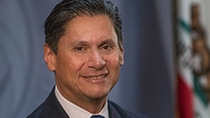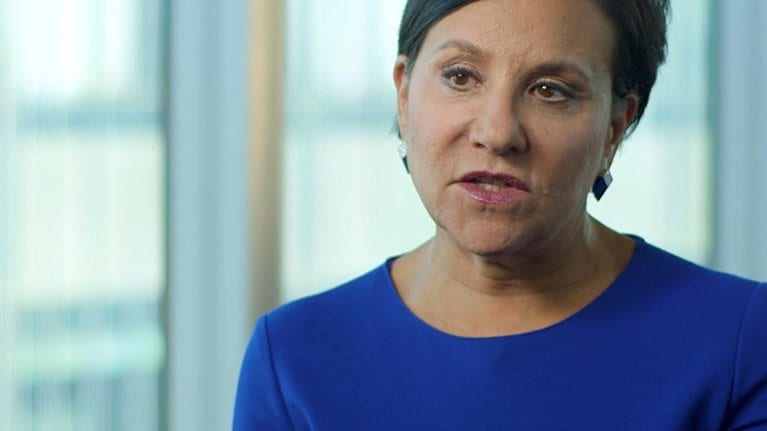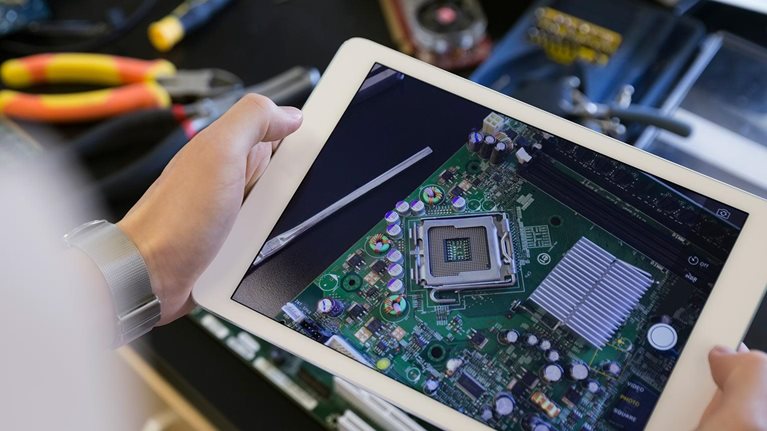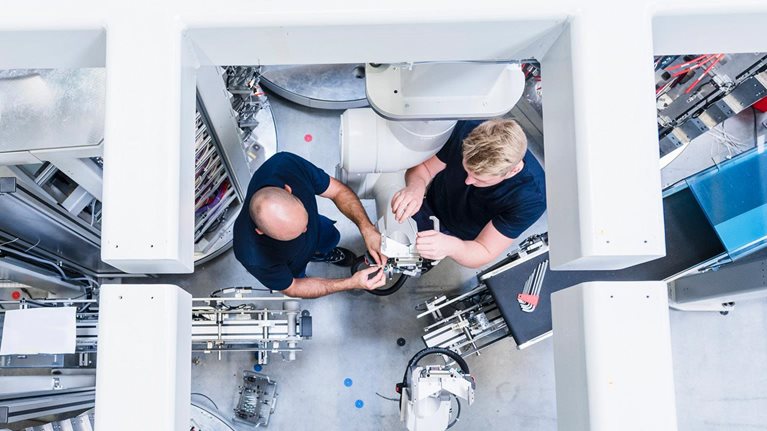The global economy is in the midst of rapid transformation. Across industries, digital technologies are destroying established business models and creating new ones, which has led to a shortfall of qualified workers to fill open positions.1 Requirements are changing so rapidly that many workers who have been with companies for years wouldn’t be considered today for those same jobs without additional credentials. It’s little wonder that upskilling and reskilling have become a top priority for companies and government administrators alike.
US community colleges—and comparable postsecondary schools in other countries—have a critical role to play. Long important players in vocational education and workforce development, their traditional focus on technical skills and industry-specific certifications have made them indispensable to sectors from manufacturing to healthcare. And with an expansive network of institutions across the country, community colleges are well placed to serve both traditional students and adult workers seeking to expand their skills and expertise.
Eloy Ortiz Oakley, chancellor of the sprawling California Community Colleges system, understands intimately how integral these institutions are to the continued vitality of a changing economy. His vantage point isn’t just professional but personal: Oakley’s experience as a community college graduate has indelibly shaped his views on the system’s role in creating a qualified workforce. We recently sat down with Chancellor Oakley at his office in Sacramento, California, to discuss the future of public colleges, the importance of public–private partnerships, and the potential of technology and online learning.
Interview transcript
McKinsey: How would you characterize the ability of public education in the US to meet the needs of today’s economy?
Eloy Ortiz Oakley: Our educational model often no longer works. The current pipeline consists of K–12 education, a four-year institution or a community college education followed by a transfer to a four-year university, and then sometimes graduate school. It is a very siloed process with rigidly segregated levels of higher education.
Instead, we may need to think about a K–14 model. We’ve seen some success with this approach across the country. P-tech is a great example: it is a six-year high-school program, developed through a public–private partnership, that allows students to graduate with both their high school and associates degrees. This model truly prepares students for the future of work.
McKinsey: What is the role of community colleges in preparing people for the workforce?
Eloy Ortiz Oakley: Whether students are coming to us right out of high school, after serving in the military, or from the workforce to reskill after a layoff, community colleges are a great fit. So many people who were able to get good jobs coming out of high school now need additional skills, often because employers are demanding postsecondary credentials.
Community colleges have both experienced faculty and support systems in place. And we open our doors to all students, regardless of where they have been, how they did in high school, or how they have done in life.
McKinsey: What are some of the ways your community college system is using technology to help students navigate through higher education?
Eloy Ortiz Oakley: One of the challenges in community colleges is that we have historically placed students in what we call remedial or developmental education classes based on their standardized test scores. That’s a disservice to these individuals because it doesn’t really represent how well they can do in college.
We are doing a tremendous amount of work to better understand students’ skills and talents, and to place them in college in a way that allows them to progress as quickly as possible. We’re getting much better information and using predictive analytics to better understand students’ educational attainment when they come to us and determine which courses they should be taking. For example, to place students today, we’re taking high school transcript data and creating algorithms that we call Multiple Measures Assessment and Placement (MMAP) models. These MMAPs will improve as we gain access to more and more data about a student’s life experiences—education, work, internships, clubs, activities and so on. As we get better at collecting that data, the MMAPs will give us much better information on how to personalize education for each individual. We want to be able to tailor an educational experience personally for you the day you walk in the door and having access to data is going to give us that opportunity. Students will be much better placed than just walking into a class of 50 as one of many, where our faculty and staff see only the average of what’s going on in that classroom.
So many people who were able to get good jobs coming out of high school now need additional skills, often because employers are demanding postsecondary credentials.
McKinsey: Community colleges have increasingly been working with the private sector on training programs and curriculums. What are the elements of effective public–private partnerships?
Eloy Ortiz Oakley: The employer–community college partnership is critical to ensure that the private sector has the workforce it needs to grow. We see the economy changing right before our eyes, so without this strong partnership we’re going to fail to educate a sufficient pool of workers.
We need employers that are invested in the future of public higher education to be at the table, helping us to design curriculum and advising us on how to upskill and reskill the workforce. For example, Genentech in the northern San Francisco Bay Area, has partnered with colleges such as Solano Community College to create and prepare an entry-level workforce. Solano Community College in partnership with Genentech has also developed a bachelor’s degree that feeds into its particular industry, enabling more folks in the workforce to move into management positions.
Most companies understand the value of partnering with broad-access public education institutions. Whether they are an automotive manufacturer or a tech company, they are already spending to train new employees, reskill them as workers progress through the ranks, and retain talent in a tight labor market. Community colleges are the ideal partner: we’re already here, we’re affordable to many students, and we’re located throughout the country. Moreover, we’re designed to adapt to the changes in the workforce much more quickly than public or private university systems can.
McKinsey: So how do you pitch a community college student alongside a student from a top-name university?
Eloy Ortiz Oakley: Part of the challenge we have today is the way that we communicate value is the diploma that you offer on your résumé. Not that one degree is better than the other, but if you have a degree from an Ivy League school, that communicates a certain value, while a degree from a public university conveys a different value. In the future, I think we’re going to rely less on where a degree came from and more on the entire picture of degrees, experience, and demonstrable skills. That’ll force us to reassess the value we create through our credentials.
The goal, really, is about building a portfolio so that people can accumulate and demonstrate knowledge to an employer. The challenge for us is, how do we take a student’s information over a lifetime and package it in a portfolio of skills for an employer, including education, military service, and skills gained as an adult learner? Think about how employers are screening applicants. They’re using various algorithms and predictive analytics to screen applicants out on a number of criteria. Applicants rarely get a chance to sit in front of people anymore for a first interview.
McKinsey: Are you talking about a digital portfolio of some sort?
Eloy Ortiz Oakley: Yes, I think having a digital portfolio is the wave of the future. Right now, every time you apply for a job or go to school for an advanced degree, you have to request your transcript from the university you last attended. That is such an outdated way of helping us understand what your skills and talents are.
In contrast, LinkedIn, Indeed, or any of the other job services are essentially digital packages. They capture work experience and duration, education, membership in different organizations, and hobbies and interests. We have also seen advances in student portfolios.
It’s really about how we package all of these skills in a way that’s transferrable and follows individuals throughout their career. It’s unclear what that will look like, but I think being able to demonstrate the accumulation of all your talents and experiences is a much better way of understanding how you’re going to fit into my company or my venture than just a college diploma.

Subscribe to the Shortlist
McKinsey’s new weekly newsletter, featuring must-read content on a range of topics, every Friday
McKinsey: You’re in the process of developing a fully online community college that will offer multiple career pathways starting in 2019. What specific needs will this college address?
Eloy Ortiz Oakley: It will be focused on competency-based education and a personalized learning experience. Our target is the adult workforce: there are 2.5 million working adults between the ages of 24 and 35 in California who have no college credential. If you extend that to age 62, that number grows to more than 8 million. These individuals are extremely vulnerable to the changes in the economy: they were severely displaced in the last recession and will be most vulnerable when the next recession hits. They have no real opportunity for economic mobility without some demonstrable skill.
We’re concerned about what is going to happen to these 8 million working adults when automation disrupts their industry. Think about the gig economy and how rapidly it is changing—one day you’re an Uber driver, the next day we have automated cars driving people around. What happens to all those workers?
This college will give adult learners the opportunity to reskill and upskill, pursue promotions, enhance their economic mobility in this economy, and gain a stronger foothold in the economy. Medical coding will be one of the first pathways offered because this role is in high demand in the healthcare field. Every time an industry changes, the jobs that are being created require the demonstration of skills—whether those are badges, microcredentials, or higher-education credentials. That trend is going to pick up speed. If we don’t begin to lay the infrastructure today, then those workers are going to be left without jobs.
McKinsey: A lot of research shows that fully online education doesn’t necessarily lead to great outcomes or teach the soft skills needed to excel in certain industries. How will you address these issues?
Eloy Ortiz Oakley: People have become much more comfortable with online learning. Think about the feedback loops that we’re all accustomed to—such as apps on our phone that tell us about our banking or credit rating. These digital tools allow us to gain more skills and knowledge about what’s going on around us.
We think that technology, particularly around competency-based education, can serve adults very well. There are no doubt places where students will need to demonstrate hands-on skills, but that’s where the employer partnership comes in. We know that employers need to certify workers with technology-enabled skills. Partnering with employer groups and labor organizations enables our colleges to offer hands-on competency certification.
McKinsey: How will you ensure that internet access won’t be a barrier to the online university?
Eloy Ortiz Oakley: We recognize that many working-class citizens can’t afford high-speed internet. For some, their phones are their only path to the internet. For basic instruction and learning, we want to make our courses very mobile friendly and device agnostic so that everyone can participate. For higher-level work, we need to work with our employers, labor partners, and municipalities to ensure that there are places a person can go to gain access to a laptop or another mobile device. We’re going to have to solve for those things.
Working-class students are sometimes working two and three jobs. They can’t just drop everything and go to a brick-and-mortar college or university. We have to try to respond, and the online community college is an opportunity to provide them with access to that competency-based education.
Partnering with employer groups and labor organizations enables our colleges to offer hands-on competency certification.
McKinsey: How do you think the fundamental operating and business model of the community college system will need to change over the next five to ten years?
Eloy Ortiz Oakley: Community colleges are no different than any other part of the higher-education system. We need to adapt to the changes gripping us today as well as the ones that are coming. We need to provide greater access to more and more individuals at a lower cost, and that’s just the reality. Even a state like California, which has seen an increase in investment in community colleges over the past five years, cannot realistically build enough brick-and-mortar institutions to keep up with the demand.
We have to find ways to lower the cost of education, and that may mean that we have to blur the lines between K–12, community colleges, and universities. We have to create much more seamless pathways and access to higher education. In addition, we’re no longer living in an environment where you get your bachelor’s degree and you’re done. We have to package credentials differently so that as industries change individuals can come back to higher education, get the credentials that they need, and increase their economic mobility.
We need to really think about how to adapt our approach to the science of learning. We know how people learn, and we know that every individual learns differently. I want our faculty to be able to take on different learning and teaching modalities, to look at how we move away from sort of the seat-time method to how we actually measure what students are learning on a real-time basis, and to use data to personalize education for an individual.
McKinsey: Ultimately, how do you quantify the value that community colleges can provide in terms of economic impact?
Eloy Ortiz Oakley: We see our value in allowing individuals to more meaningfully participate in civic life. That’s a huge issue for us. We’re also looking at an individual’s ability to transfer to a university and then follow them into employment.
Many of our students come to us from some of the lowest social and economic ranks in America. Can we take those individuals and put them on the path to the middle class? Can we give them the necessary skills? How do we measure that economic and social value? We need to do a much better job with those metrics. So, placement in the jobs, meaningful wage gain, allowing the individual to continue to come back and reskill and upskill that enables more and more economic mobility.
I think we need to expand how we define success and progress. The ideal is to get away from measuring only credential production. That’s an important metric, but we need to do a better job of measuring the economic value that we’re creating for individuals as well as economic mobility. In many cases, individuals come into our system and don’t complete a credential because they have gotten the education needed to achieve mobility in their place of employment.
We also need to measure the economic value of credentials. We want to get away from these metrics on how many degrees did you confer and how many students transferred to four-year universities. Instead, the focus should be on the benefits to individuals, communities, and the nation as whole.
Now is the time to begin to do the work to build the infrastructure. That is my wish for all of our community college leaders: that we embrace this new economy and do everything possible to prepare our students and working-age adults to not only survive but thrive.



